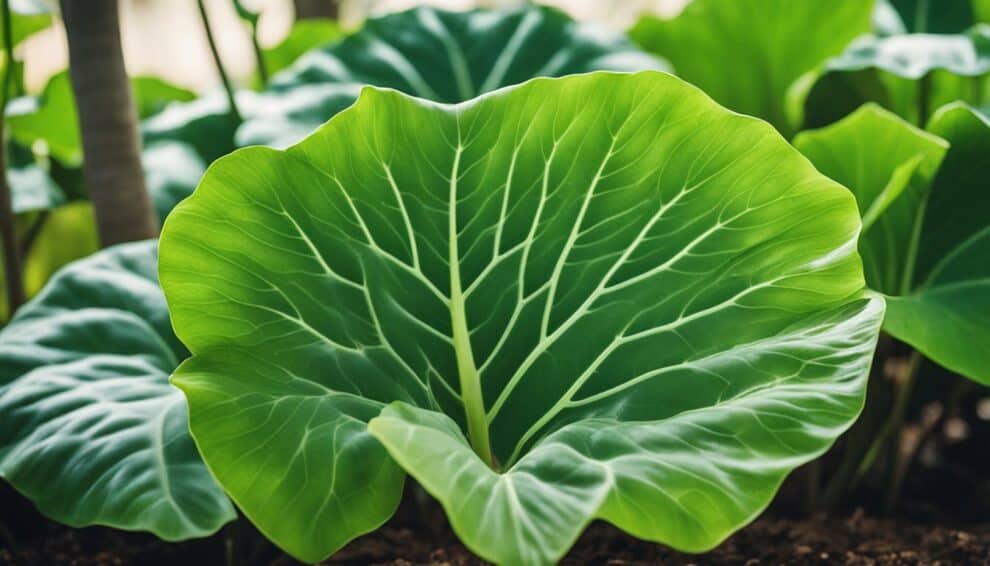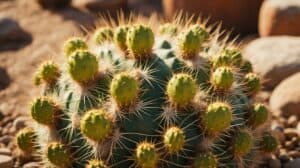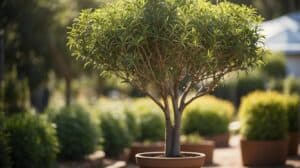Colocasia Esculenta, commonly known as the taro plant, is a tropical plant that is widely grown for its starchy root vegetable.
The taro plant is native to Southeast Asia and has been cultivated for thousands of years.
It is a popular ingredient in many cuisines, including Hawaiian, Indian, and African.

For those who are new to growing taro plants, it can be a bit daunting.
However, with the right care and attention, anyone can successfully grow this delicious and versatile plant.
In this article, we will provide some helpful tips and tricks for novice gardeners looking to grow colocasia esculenta.
From choosing the right soil to proper watering techniques, we will cover everything you need to know to get started.
So, whether you are a seasoned gardener or a beginner, read on to learn more about taro plant care.
Getting to Know Taro
Origins and History
Taro, also known as Colocasia Esculenta, is a tropical plant that has been cultivated for thousands of years.
It is believed to have originated in Southeast Asia and spread to other parts of the world, including Africa, the Caribbean, and South America.
In many cultures, taro is an important staple food and is used in a variety of dishes, such as soups, stews, and curries.
Characteristics of Colocasia Esculenta
Taro is a herbaceous perennial plant that can grow up to 6 feet tall. It has large, heart-shaped leaves that can be up to 2 feet long and 1.5 feet wide.
The plant produces a corm, which is a swollen underground stem that is used for food. The corms can vary in size and color, depending on the variety.
Some taro plants produce corms that are white, while others produce corms that are pink, purple, or black.
Taro plants prefer warm, humid climates and thrive in moist, well-drained soil.
They can be grown in both sun and shade, but they require regular watering and fertilization to produce healthy corms.
Taro plants are also susceptible to pests and diseases, such as taro leaf blight and root rot, so it is important to monitor them closely and take appropriate measures to prevent or treat any problems.
In summary, taro is a versatile and nutritious plant that has a long history of cultivation in many parts of the world.
With proper care and attention, even novice gardeners can enjoy growing and harvesting their own taro plants.
Essential Care Instructions

Soil Requirements
Colocasia esculenta, commonly known as taro, requires well-draining soil that is rich in organic matter.
A pH level ranging from 5.5 to 7.0 is ideal for the plant’s growth. The soil should be kept moist but not waterlogged, as this can lead to root rot.
Adding a layer of mulch around the plant can help retain moisture and keep the soil cool.
Watering Needs
Taro plants require consistent moisture to thrive. They should be watered regularly, especially during dry spells.
The frequency of watering will depend on the climate and soil conditions. Overwatering should be avoided, as it can lead to root rot.
It is recommended to water the plant deeply once a week, rather than frequent shallow watering.
Light and Temperature
Taro plants prefer partial shade to full sun. They can tolerate temperatures ranging from 65°F to 95°F.
However, they do not tolerate frost or freezing temperatures.
It is important to protect the plant from cold drafts and strong winds, as they can damage the leaves.
Fertilizing Guidelines
Taro plants require regular fertilization to promote healthy growth.
A balanced fertilizer with equal amounts of nitrogen, phosphorus, and potassium is recommended.
Fertilization should be done every 4-6 weeks during the growing season. Over-fertilization should be avoided, as it can lead to salt buildup in the soil.
By following these essential care instructions, novice gardeners can easily grow and maintain healthy taro plants.
Propagation and Planting

Propagation Methods
Taro plants can be propagated through corms, which are the swollen underground stems.
Corms should be planted in well-draining soil with a pH level between 5.5 and 7.0. The corms should be planted 2-4 inches deep and spaced 12-18 inches apart.
It is important to note that taro plants prefer moist soil, so it is recommended to water them regularly.
Another method of propagation is through suckers, which are small plants that grow from the corms.
To propagate through suckers, gently separate them from the parent plant and plant them in their own pot or in the ground.
It is important to ensure that the soil is moist and well-draining.
Planting Steps
Before planting, it is important to prepare the soil by adding organic matter such as compost or well-rotted manure.
This will help improve soil fertility and drainage.
Taro plants prefer full sun to partial shade, so it is important to choose a location that receives at least 6 hours of sunlight per day.
When planting, dig a hole that is twice the size of the corm and add a layer of organic matter to the bottom of the hole.
Place the corm in the hole with the pointed end facing upwards and cover it with soil.
Water the plant immediately after planting and continue to water regularly.
It is important to note that taro plants can grow quite large, so it is recommended to space them at least 12-18 inches apart.
Additionally, taro plants can be grown in containers, but they will require frequent watering and fertilization.
Common Issues and Solutions

Pest Problems
Taro plants are susceptible to various pests, including aphids, spider mites, and mealybugs.
These pests can cause damage to the leaves and stems of the plant, leading to stunted growth and reduced yield.
To prevent pest infestations, it is important to keep the taro plant healthy and well-nourished.
Regularly inspect the plant for signs of pest activity, such as yellowing leaves or webbing on the leaves.
If a pest infestation is detected, there are several natural remedies that can be used to control the pests.
For example, spraying the plant with a mixture of water and dish soap can help to suffocate and kill pests like aphids and spider mites.
Additionally, introducing natural predators like ladybugs or lacewings can help to control pest populations.
Disease Management
Taro plants are also susceptible to various diseases, including fungal infections and bacterial blight.
These diseases can cause discoloration of the leaves, wilting, and stunted growth.
To prevent disease, it is important to maintain good hygiene practices when handling the plant.
Always use clean tools and avoid working with the plant when it is wet, as this can promote the growth of fungal spores.
If a disease is detected, it is important to take immediate action to prevent the spread of the disease.
This may involve removing infected plant material, treating the plant with fungicides or bactericides, or adjusting the environmental conditions to promote plant health.
By taking proactive measures to prevent pest infestations and disease, novice gardeners can successfully grow and maintain healthy taro plants.
Frequently Asked Questions

How should I water my Colocasia esculenta indoors to promote healthy growth?
Colocasia esculenta requires consistently moist soil to thrive.
When watering, ensure that the soil is thoroughly saturated, but avoid letting the plant sit in standing water.
It’s essential to allow the top inch of soil to dry out before watering again.
Watering once a week is usually sufficient, but adjust the frequency based on the plant’s specific needs and the conditions in your home.
What are the best practices for overwintering Colocasia plants?
Colocasia esculenta is a tropical plant and cannot tolerate frost.
If you live in a region with cold winters, you’ll need to take steps to protect your plant.
Before the first frost, dig up the plant and remove any dead or damaged leaves.
Cut back the stems to about six inches and store the plant in a cool, dark place with high humidity.
You can also overwinter the plant in a container indoors.
Can you provide tips for growing Colocasia in containers?
Colocasia esculenta is well-suited for container growing. Choose a container that’s at least 12 inches in diameter and has drainage holes.
Use a high-quality potting mix and ensure that the soil stays consistently moist.
Fertilize the plant regularly during the growing season, and provide ample light and humidity.
What is the ideal lighting setup for a taro plant kept indoors?
Colocasia esculenta requires bright, indirect light to thrive.
Place the plant near a window that receives plenty of natural light, but avoid direct sunlight, which can scorch the leaves.
Supplemental artificial light can be beneficial, especially during the winter months when natural light is limited.
How often should I fertilize my Colocasia esculenta, and what type of fertilizer is recommended?
Colocasia esculenta benefits from regular fertilization during the growing season.
Use a balanced, water-soluble fertilizer and follow the manufacturer’s instructions for application rates.
Fertilize every two weeks during the growing season and reduce fertilization during the winter months.
What are the common pests or diseases that affect Colocasia, and how can I prevent them?
Colocasia esculenta is susceptible to a range of pests and diseases, including spider mites, mealybugs, and root rot.
To prevent these issues, ensure that the plant is grown in well-draining soil and avoid overwatering.
Monitor the plant regularly for signs of pests or disease, and treat promptly with the appropriate method.














